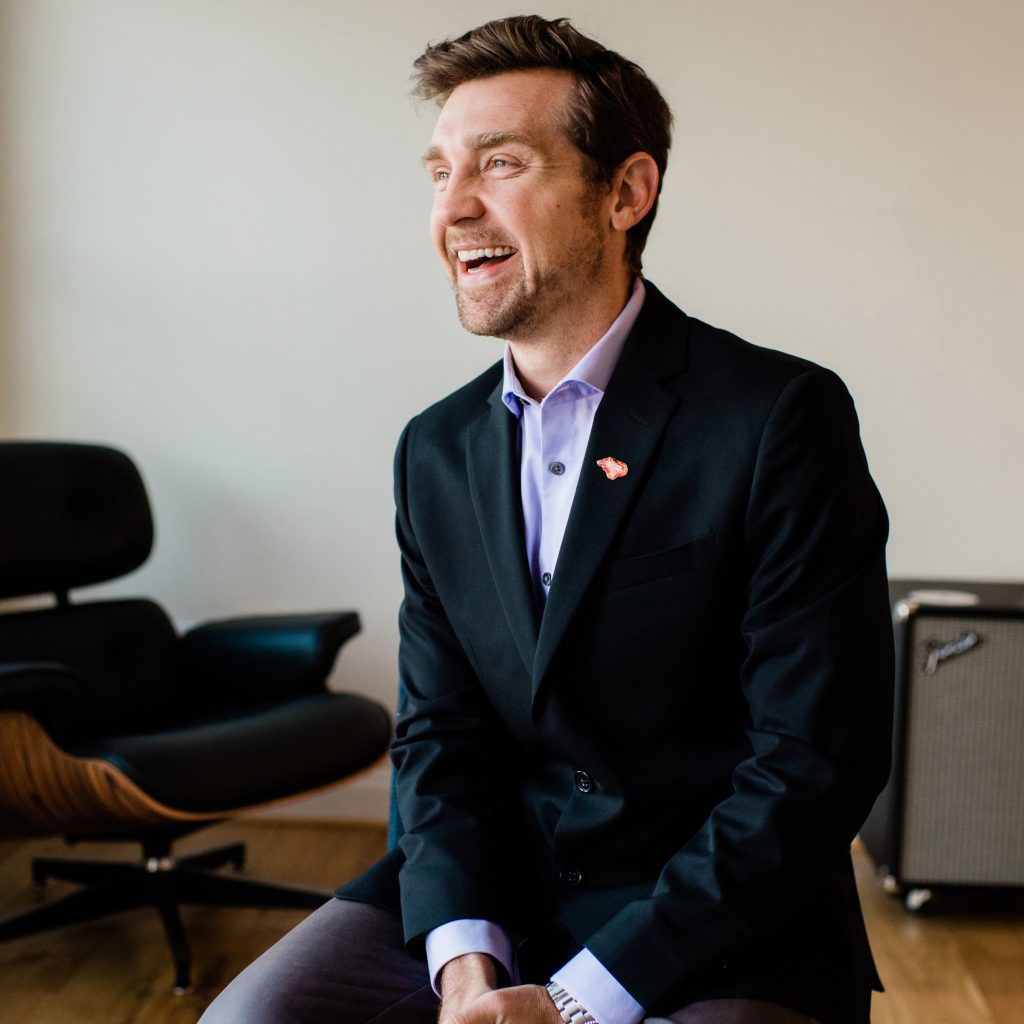Episode 1: Defying Distance with Distributed Teams
Duration: 30min
About our guest:

Darren Murph
Named an “Oracle of Remote Work” by CNBC and featured in The Forbes Future of Work 50, Darren is a recognized visionary in organizational design. He has partnered with an array of global brands, including Dolby, Vistaprint, Dropbox, Mozilla and Samsung and has been featured on CNBC, CNN, The Washington Post, TechCrunch, Business Insider, and more.
Share episode
How can managers make sure their remote teams don’t just survive, but thrive? We sit down with Darren Murph who’s been preaching the benefits of borderless offices for almost two decades, earning him the moniker ‘Oracle of Remote Work’. He’s even proven the skeptics wrong by helping GitLab become the first fully remote company to go public, authoring their pioneering Remote Work Playbook. Together, we cover everything from the tools that improve async work to how workplace culture is teetering on the verge of a seismic shift.
Plus: Darren’s top tips on the traits leaders need to succeed in transitioning to a remote-working future.
Key takeaways:
Intentionality propels remote teams to purposefully gather, fostering innovation, synergy, and a thriving culture. In remote work settings, people are the key to organizational success.
Certain management styles promote team empowerment without the need for micromanagement. Forward-thinking leaders create a frictionless remote collaboration ecosystem that fuels autonomy and creativity.
A Google study highlights that team co-location isn’t what truly matters. Instead, prioritizing psychological safety in human-centric work models boosts job satisfaction, mental health, creativity, and productivity.
The Dark Horse skill of the future is low context communication. Being able to convey information explicitly without relying on shared cultural or contextual knowledge reduces misunderstandings.
The future of workplace culture is moving beyond physical offices. Organizations that embrace and empower this shift, rather than resisting it, will lead the way in this cultural revolution.
More episodes we think you’ll love

January 31, 2024 • 38 min.
•
People Management | Learning & Development
Defining & Decoding Company Culture
What is company culture? Is it ping-pong tables and perks? Is it the values we talk about internally? Or is it the way the company works “on a random Tuesday in October”? With experience at Disney, Nike, and Google, Talent Exec, Andre Martin joins the discussion. Join us and find out why authenticity and intention lie at the heart of a consistent culture.

December 20, 2023 • 37 min.
•
Organizational Design | People Management | Learning & Development
Empathy and Inclusivity in the Workplace
What does it mean for an organization to be truly inclusive? How can you confront biases and become an active ally without causing conflict? We sit down with Dr. Poornima Luthra, an author, academic, educator, and consultant. From the hiring process to the c-suite to the lunch room, we look at ways we can challenge day-to-day biases we might not even be aware of to create an environment that works for everyone.

December 6, 2023 • 40 min.
•
Organizational Design | People Management | Learning & Development
Preparing for the AI-powered workplace
What’s on the horizon beyond ChatGPT? How can you prepare for AI-led digital transformation? We sit down with Ronald Ashri to discuss everything from employee privacy to rethinking how teams are trained and emerging new AI-related roles (prompt engineers?!). Join us as we skip the speculation and get stuck into the concrete considerations organizations should take into account when adopting new AI tools.

Never miss an episode! Get every new drop right in your inbox
Full Episode Transcript
Host: Today, on our very first episode, we’re talking to the so-called Oracle of Remote Work, Darren Murph.
He’s currently the Head of Technology Strategy Communications at Ford Motor Company. And before that, he was head of remote at GitLab, helping the company scale from a startup to the world’s first fully remote company to go public. He also authored GitLab’s Remote Playbook, an essential and straightforward read for any team curious or certain that they want to make the leap into the world of remote working.
I’m really excited to hear his thoughts. On the most common mistakes companies can make when rushing to go remote, why rethinking communication is vital when making the change, and what skills are going to be the most valuable in this new age of work. Stay with us. [00:02:00]
Host: Hi, Darren, thank you so much for making the time to join us. How are you today?
Darren Murph: Of course. Thanks for having me. I’m doing well. Hope you are.
Host: Same, same here. Doing great, thankfully. It is not as warm as the past couple of weeks have been.
Darren Murph: We’re getting the earliest stages of fall leaves, which are beautiful. So loving the color, loving the heat, trying to savor every moment of summer. Doing well.
Host: I’d love to kick off with you just sort of walking us through your professional journey. How did you get to where you are now?
Darren Murph: Yeah, I think, the earliest point of inflection for me was a mindset shift. And so I’ll give you kind of an AB comparison. I think most people are conditioned by society to answer the question, what do I want to do when I grow up?
And then they allow society to tell them where they’re going to live and essentially build the walls around the answer to that question. And I can never square that. I saw it as an opportunity to say, what kind of life do I want to live? Who do I want to be? What is the legacy that I want to leave? [00:03:00]
Trying to look ahead to when I’m 80 or 90 years old, like what would be written about me, and then work backwards from there. And when I began that journey, It became clear to me that tying myself to a conventional nine to five job that was connected to a physical location in a city around the world would not be accommodating for this lifestyle.
I credit my parents for embedding the wanderlust gene in me. I did not grow up wealthy, but I was fortunate enough to have parents that really strive to take me places and help me see that there was a world beyond where I was born. And that was just enough of a glimpse. Into the reality that this world is really big and it’s worth perusing and seeing and embedding yourself in cultures if at all possible. [00:04:00]
And that was the inspiration to really set me on a journey to find what I loved to do in life, kind of my gifts to the world, overlaid with working with people and organizations that were progressive enough to see the value of flexibility. And that was the entry point into what has been a career across the spectrum of distributed work.
Host: What was that first organization that saw the value in it?
Darren Murph: Yeah, it was prior to the pandemic. It was 2006, believe it or not. And so remote work—really, it wasn’t even termed at that point. I think the term at the time was telecommuting. A few organizations were doing this. It really started with Engadget.
So my career began in the world of editorial and storytelling. Engadget was a consumer technology publication. It still is a consumer technology publication. And we made it into one of the first globally distributed consumer technology publications. And so although there was a Headquarters, there was an office in New York city, the majority of our team worked remotely. [00:05:00]
We had editors and writers on six continents, and we intentionally built a global team around that. And being in that environment, being in a position to help build that environment, build the infrastructure that’s needed. For collaboration and connection to happen across six continents was an amazing learning experience because again, this was 2006.
No infrastructure existed. So we were having to build this in real time and it was a transformational journey because I recognize that a) we could hire the best people no matter where they were in the world and so that gave us a massive competitive advantage but b) working in that way enable people to live and design their lives in a way that was monumentally more fulfilling than their peers who were more tightly tied to an office. [00:06:00]
So this was, if you’re familiar with the matrix, this was a red pill moment. So once you see what is possible, when you have a workplace that supports flexibility and builds infrastructure around it. It’s really hard to unsee it, and you don’t want to give that agency up.
Host: So, Darren, you mentioned GitLab, and I just want to take you back to your time there and ask you about the Remote Work Playbook, which I’m going to dive into a little later, with some key takeaways. But for our listeners, can you briefly explain what it is and how it came about? How does it help business in general?
Darren Murph: The GitLab Remote Playbook is a blueprint for how to build, run, scale, remote infrastructure, and it was built around this principle at GitLab, which is transparency is a value. GitLab for context for listeners. GitLab in 2021 became the first office list, the first fully remote by design company to ever IPO. [00:07:00]
This was historic and monumental for a few reasons. One is that remote work had plenty of detractors, and there were plenty of people who said remote work can’t scale. Maybe it works for smaller teams or in very specific industries, but it can never scale to be something meaningful. So even pre-COVID, GitLab was on a mission to prove that wrong.
And GitLab has a value of transparency. And so folks who would google “GitLab remote work” would land in what we call our company handbook. We made this handbook public on the web, and if you dive into it, it is essentially the operating manual for the company. It’s a fascinating case study in what happens when you’re transparent, the lessons that you learn from that, and how you enable everyone to contribute. [00:08:00]
This is very core to the open core, open source ethos, which runs deep, at GitLab. And so we codified the top tips, if you will, in what it takes to run a remote company. And we put them together in a playbook and we started building this pre-COVID because it’s something that we wanted to do to share with the community.
But when COVID happened, it became incredibly valuable to many, many organizations around the world that would have never looked for this asset, if not for a pandemic, forcing them into being in a remote situation. So that created quite the spotlight for the work that we did at GitLab. And at last check, there was over 150, 000 downloads of that asset.
And I’m sure the number is higher since, since I last checked. But it’s safe to say that the fingerprints of GitLab’s remote infrastructure are all over the world.
Host: And since then, a lot of different remote work has emerged, as you mentioned, because of the pandemic. So there’s fully remote, hybrid work, distributed teams. [00:09:00]
Do you think that all these require nuanced changes to management style? Or is there a general rule for management that can be applied to all these different kinds of remote working models?
Darren Murph: It’s a great question. I think we are very close to the tipping point where remote work is just work. We have moved beyond the debates on “Will a company be remote or not?”
The truth is, in 2023 onward, any organization that is digital at all is already distributed to some degree. And even pre-COVID, I would argue that an organization that was in one building in one city, but it had multiple floors. The people on different floors were already remote to one another.
There’s plenty of research that shows that if you segment people in different buildings or different floors, unless you intentionally build avenues and pathways for them to interact, it’s as if they’re oceans away. So organizations need to understand remote-first principles, even if they don’t culturally consider themselves a remote company. [00:10:00]
And the good news is what I learned to GitLab. Many of it boiled back down to first principles. At its core, a great remote team is a great team. There are certain things that remote teams do that are non-negotiable in a distributed setting. Things like codifying your operations, being intentional about in-person gatherings, so on. But I would argue that any organization could learn from this.
Host: Definitely. You touched a little bit on in-person and how even if being on different floors, you know, there is that remote element. Do you feel that perhaps there are some management styles that work in-person or used to work in-person that might not work when it comes to managing a remote team? [00:10:00]
And even to the extent of, you know, having people on different floors or different offices across the globe.
Darren Murph: So there’s two layers there. One is in-person and one is management style. And I’ll say that the best distributed teams have a dedicated in-person strategy. So a lot of organizations are struggling with going remote.
If you really start digging into why, a lot of it can boil down to there’s no intentionality. There’s no budget around how and why to get people together. When you had everyone marching into the office every day, you really didn’t have to plan this. It took care of itself. But in the absence of that, you really have to be more intentional about planning off-sites, planning these rhythms, ensuring that people do have touch points.
Look, we’re humans, we’re relational, communal beings, in-person moments, in-person experiences are really, really important. So baking them into the strategy instead of them being an afterthought is really critical. On the concept of management style, the short answer is yes. There are some management styles that are more amenable to distributed work. [00:12:00]
But where I want to go with this is that leaders can build systems that make this easier. I’ve often heard that if people are remote, I don’t know if they’re working. I have a hard time judging productivity. I don’t know if my leadership or guidance or stewardship is actually being as effective or impactful as I would like, and I’m a systems thinker.
So I go back and ask, as an organization, what systems can we put in place that make it easier to make it more frictionless for people to get work done and show their work? One of the aha moments I had at GitLab is that we did all of our collaboration within the GitLab platform itself, and it would actually keep tabs on all of your contributions across various projects. [00:13:00]
So you didn’t have to report out on what you were doing. We used a system that reported as you worked, and I think this is a glimpse into the future. Tools will be built that make it easier for managers, leaders and even individual contributors to show what they’re working on, to share what they’re working on, and with the advent of large language models, I think it will become even easier for people to ask the system: What is the status on this instead of asking a person?
So I think this will make it easier for more management styles to work in a distributed setting because they don’t have to learn an entirely new way to manage and lead.
Host: Did you ever find that anybody felt micromanaged? Because I can imagine the benefits. I understand, you know, you don’t have to be reporting everything that you’re doing, but having such a microscope on what you are working on. At any point, did you get any of that backlash? [00:14:00]
Darren Murph: It’s a very personal thing. Where I go with that is I try to go back to first principles and work backwards.
What I found is that if a manager in a direct report could have an open conversation and answer the question, “What does success look like?” If they could both answer that question, it really removes the micromanagement microscope. And it is amazing how many organizations simply don’t ask or answer that question.
There’s a lot of ambiguity around what does success look like? What are our goals? And answering that question is critical to breaking through that. I also found a Google research study from 2015, believe it or not. Where they researched the number one theme was psychological safety. And mind you, this was in 2015, well before COVID.
And why I think that’s important to surface is it really mirrors the research that’s coming out today. Gartner ran a study in late 2022 and found that the highest performing teams utilized what they called “human-centric work models.” [00:15:00]
And at the core of that was an appreciation of flexibility, empathy and psychological safety. And it’s one of these interesting moments that the more things changed, the more they stayed the same. And so although COVID has introduced new dynamics of work, the principles in large part are the same. And for managers that are trying to get better at leading remotely, for me, it goes all the way back to “How can I create psychological safety?”
Now, the creation of that could look different in a remote setting, but it was important then. And it’s important now. The one other point that I’ll mention about this Google study is that they found co-location of colleagues had no impact on the effectiveness of teams. And I find this amazing for a couple of reasons.
One, this was in 2015. Two, this was from Google, which even today still strongly prefers teams to be together in-person. Yet, almost a decade ago, the data showed that element wasn’t essential. Things like psychological safety were way more important than the co-location of colleagues. [00:16:00]
Host: That’s crazy, the fact that it was in 2015, but also to consider that there’s such a big struggle even today after pandemic, after remote working has become a bit of a norm, or at least the hybrid model has. Now you’ve said before that right now, remote work offers the autonomy of space, but in the future it’ll be about having the autonomy of time. Can you talk us through what you mean by that and some simple steps managers can take to prep their teams for this shift?
Darren Murph: The current frontier of remote work is decoupling business results from physical location. [00:17:00]
And many organizations have come to grips with this. But the next frontier of remote work is far more powerful, and that is decoupling business results from linear time. In other words, enabling people to work more flexibly with every 24-hour day that they get. This is still a major struggle for most organizations for two reasons, culture and systems.
The culture is hanging on to the past where there is this understood notion that people report in from one hour to another hour. And so they optimize the way they think about work and collaboration based on that being an absolute truth. But when it is not an absolute truth, you need to look the systems in order to change the culture.
When you use systems that enable teams to collaborate more asynchronously. Loom is a great example of this, where you’re able to screen share and record. A video captures a problem statement and then send it to multiple people for them to reply on their own time. This is a game changer tools like Zimbly. They act as an AI-based chief of staff that kind of goes into your calendar, integrates and looks at other calendars of people that you collaborate with. [00:18:00]
You try to find the best times for synchronous meetings and then offer suggestions and meeting notes to move work forward without needing a meeting. The battle between sync and async, I think will rage on for a long time, but I always try to diffuse that by not looking at it as a battle, but as two tools in the toolbox.
People need to get better at leveraging synchronous time, but they also need to improve their asynchronous skills. And so if you’re looking for tips, I would say start by asking yourself, what meetings do we have that could be done in a better way? Even if it’s a simple exercise, it’s auditing your recurring meetings and trying to reduce them by 10%.
I have this, this phrase that I try to use with people, which is “no agenda, no attenda.” Which is a simple phrase that reminds you that if you’re creating a work-related meeting invite, it needs an agenda attached to the invite. Because if there’s no agenda, it’s unclear why the meeting is happening or what you hope to get out of it. [00:19:00]
And to be honest, it’s a bit disrespectful of people’s time. And so by adding that small layer of friction to add an invite or add an agenda to the invite, it’s showing more respect for the people that you’re inviting. And it’s also clarifying the reason why you’re having the meeting and what you hope to get out of it.
Host: So Darren, you’ve talked before about low context communication. And how that can be the skill of the future, which I imagine comes to play a lot with asynchronous working environments and work collaboration. What does that look like exactly? And how can companies ensure their employees can communicate in this way? [00:20:00]
Darren Murph: I’ve called this the dark horse skill of the future. So if you want to learn one thing that will open up the most doors, it would be mastering the art of low context communication. It helps to understand what that means. It’s a bit of a paradoxical statement. It means that you communicate, assuming that your target audience has low to no context about whatever it is you’re talking about.
So what that means is that you actually communicate with a very high degree of precision and detail. So what is the objective of low context communication, or how do you know that you’ve done it right? If you’ve communicated in a way that enables someone to “loop” themselves into a project, instead of just providing enough information so that you still need a meeting for them to get up-to-speed on what you’re talking about, this is the big inflection point for communicating with low context. [00:21:00]
Now, in practice, this means that communication takes longer. There’s more detail and if you’re writing, it’s going to be a new muscle to learn if you don’t love writing or you haven’t mastered the art of written communication, but it is really, really important. And as you see, team is becoming more geographically distributed across time zones.
You’re starting to see that written communication or using your voice and then transcribing it in an intelligent way is becoming a very powerful way to scale information. So, as teams become more geographically distributed across time zones, and we embrace nonlinear workdays, it’s becoming more and more difficult to move work forward.
Through the use of a conventional synchronous meeting, I see this as an inevitability and so getting better at communicating in ways that don’t rely on synchronicity would be a tip for those looking to build an edge for the future. [00:22:00]
Host: And that’s also a great tip for our listeners. The fact that you can always at the end, ask yourself, does this need a follow-up meeting to be clear?
And regarding training and onboarding, it’s a crucial part of an employee’s journey when they first join an organization. What would you say are some key factors companies might need to consider when onboarding remotely so that the experience remains as impactful as it would have in-person? I know you’ve mentioned in the past. When it comes to hiring remotely to hire for value, not culture.
Darren Murph: For sure. It’s so critical to hire for values-fit, not culture-fit. And values-fit requires the organization to understand what its values are and how they are lived out. So if you’re interviewing, talk about values, they matter. [00:23:00]
The engagement in an organization, the satisfaction in any role is so closely tied to how values-aligned you are. And so if organizations do things like value staying late or working on weekends, instead of building systems that enable work to happen more efficiently, you need to know that, are your values aligned with the way that the organization is moving forward? It’s a critical, a critical piece.
Host: So Darren, what do you think the workplace of the future, say in three, five years, or even 10, or 15, will look like in terms of distributed teams and ways of working? How can companies prepare?
Darren Murph: I think the most obvious, most notable change that you’ll see is that workplace culture will largely be built outside of the workplace.
And this is a seismic shift. So what does this actually look like? It means that instead of organizations getting people together for a Zoom happy hour, we’ll call it, they can take that same hour that they would have brought everyone together and they can deploy people out into their local communities with a simple request. [00:24:00]
Go do something that’s meaningful and fulfilling to you. And if you do that, you may see some people go volunteer their time at a local orphanage, if they’re an adoptive parent like I am, They may go to Habitat for Humanity to build homes for the less fortunate. They may dig into philanthropy. They may dig into church or community or music making.
Any number of things that make up what I call people’s purpose portfolio outside of work. But the key enabler here is that you create an environment where people are comfortable sharing photos, videos, and stories of those moments back at the workplace. So imagine the week after that you join a team meeting and the first five minutes are spent catching up on what everyone did outside of work with that targeted hour last week. [00:25:00]
You open up all sorts of avenues for people to bond around actual passions in life. This is so much more rewarding and fulfilling than just talking about something that is more superficial, which largely happens in the workplace today. So I think more of this will happen as teams become more distributed.
People are seeing that time is precious in this world and where they choose to call home is really important and the local communities around them are incredibly important and worth investing in. So organizations that see this, and instead of trying to fight it, actually enable it and empower it, will be at the forefront of this movement.
Host: As we near the end of this episode, we really can’t understate the practical importance of the Remote Work Playbook. And as Darren mentioned, it’s impacted companies and organizations across the globe. [00:26:00]
Let’s take a closer look at what’s inside this holy grail of remote work, or better, what should you really walk away with? Because, as we’ve seen, managing a remote team is a lot like managing a company, and it needs to come with its own set of rules.
According to the playbook, these are the four pillars, or the bedrocks, of remote work. Number one, transparency. At times a bit of a buzzword, but all it means is, be as open as you can, making sure all the information that should be available to your team, is. It’s a crucial step in building trust.
Next, documentation.
Why not create a handbook? It’s a source of truth and establishes a status quo. Something teams can lean on when making decisions and following processes. Hopefully closing the door on endless clarifying and confirming, and making sure everyone is on the same page. [00:27:00]
Number three, work asynchronously.
Not only is asynchronous working more efficient and better for productivity, it’s also great for employee wellness, giving each employee autonomy over their own workflow. Finally, break down silos. Look for ways to build connections between departments within your organization, because cross-functional communication really can lead to better and overall more creative results.
And one last point, when it comes to establishing communication styles and strategies within their remote teams, managers often struggle. And key to the equation is the often overlooked informal communication. Without offices, the ageold cliché of having a chat by the water cooler no longer really exists. [00:28:00]
So leaders have to start thinking outside the box. Without this kind of informal communication, employees can become lonely or burnt out.
Thanks for tuning in. In the next episode, we’re speaking to Henrik Kniberg, the consultant who’s worked with the likes of Spotify, Lego, and Minecraft. This episode of Keep It Simple was brought to you by TalentLMS, the training platform built for success and designed with simplicity in mind.
You can find Keep It Simple on all podcast platforms. Be sure to subscribe so you don’t miss an episode. For further resources on today’s topic, visit talentlms.com/podcast.[00:29:00]

Train your people. Measure results. Drive growth.
TalentLMS gives you the tools to supercharge every step of your training.





